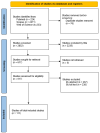The Use of Wearable Systems for Assessing Work-Related Risks Related to the Musculoskeletal System-A Systematic Review
- PMID: 39767409
- PMCID: PMC11675614
- DOI: 10.3390/ijerph21121567
The Use of Wearable Systems for Assessing Work-Related Risks Related to the Musculoskeletal System-A Systematic Review
Abstract
Work-related musculoskeletal disorders (WRMSDs) are a leading cause of chronic conditions among working-age adults. Preventing these disorders is crucial to reducing their impact, and quantitative analysis through sensors can help identify their causes and guide ergonomic solutions. This systematic review aims to compile research from 2000 to 2023 published in English and sourced from Web of Science, Scopus, or PubMed that examines workers' movements during tasks using wearable sensor systems that are applicable in workplace settings. The goal is to identify the job sectors that have been studied and highlight tasks lacking ergonomic risk research. A total of 111 papers were selected through a screening process across three databases, assessed using the McMaster risk of bias tool. The studies span various job sectors and report on the use of different technologies for data collection and study population sizes. The review identifies existing research on WRMSD risks utilizing wearable systems in different job sectors, drawing attention to under-researched areas that warrant further study. It serves as a foundation for future research aimed at understanding the causes of WRMSDs and developing solutions supported by wearable technologies to mitigate these risks.
Keywords: ergonomics; musculoskeletal disorders; review; wearable systems; work-related tasks.
Conflict of interest statement
The authors declare no conflicts of interest. The funders had no role in the design of the study, in the collection, analysis, or interpretation of the data, in the writing of the manuscript, or in the decision to publish the results.
Figures




References
-
- de Kok J., Vroonhof P. Work-Related Musculoskeletal Disorders: Prevalence, Costs and Demographics in the EU. European Agency for Safety and Health at Work; Bilbao, Spain: 2019. Technical Report.
-
- Jørgensen M.B., Gupta N., Korshøj M., Lagersted-Olsen J., Villumsen M., Mortensen O.S., Skotte J., Søgaard K., Madeleine P., Samani A., et al. The DPhacto cohort: An overview of technically measured physical activity at work and leisure in blue-collar sectors for practitioners and researchers. Appl. Ergon. 2019;77:29–39. doi: 10.1016/j.apergo.2019.01.003. - DOI - PubMed
-
- Ranavolo A., Draicchio F., Varrecchia T., Silvetti A., Iavicoli S. Erratum: Alberto, R. et al., Wearable Monitoring Devices for Biomechanical Risk Assessment at Work: Current Status and Future Challenges—A Systematic Review. Int. J. Environ. Res. Public Health 2018, 15, 2001. Int. J. Environ. Res. Public Health. 2018;15:2569. doi: 10.3390/ijerph15112569. - DOI - PMC - PubMed
Publication types
MeSH terms
Grants and funding
LinkOut - more resources
Full Text Sources
Medical

